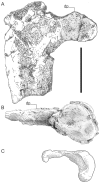On the size and flight diversity of giant pterosaurs, the use of birds as pterosaur analogues and comments on pterosaur flightlessness
- PMID: 21085624
- PMCID: PMC2981443
- DOI: 10.1371/journal.pone.0013982
On the size and flight diversity of giant pterosaurs, the use of birds as pterosaur analogues and comments on pterosaur flightlessness
Abstract
The size and flight mechanics of giant pterosaurs have received considerable research interest for the last century but are confused by conflicting interpretations of pterosaur biology and flight capabilities. Avian biomechanical parameters have often been applied to pterosaurs in such research but, due to considerable differences in avian and pterosaur anatomy, have lead to systematic errors interpreting pterosaur flight mechanics. Such assumptions have lead to assertions that giant pterosaurs were extremely lightweight to facilitate flight or, if more realistic masses are assumed, were flightless. Reappraisal of the proportions, scaling and morphology of giant pterosaur fossils suggests that bird and pterosaur wing structure, gross anatomy and launch kinematics are too different to be considered mechanically interchangeable. Conclusions assuming such interchangeability--including those indicating that giant pterosaurs were flightless--are found to be based on inaccurate and poorly supported assumptions of structural scaling and launch kinematics. Pterosaur bone strength and flap-gliding performance demonstrate that giant pterosaur anatomy was capable of generating sufficient lift and thrust for powered flight as well as resisting flight loading stresses. The retention of flight characteristics across giant pterosaur skeletons and their considerable robustness compared to similarly-massed terrestrial animals suggest that giant pterosaurs were not flightless. Moreover, the term 'giant pterosaur' includes at least two radically different forms with very distinct palaeoecological signatures and, accordingly, all but the most basic sweeping conclusions about giant pterosaur flight should be treated with caution. Reappraisal of giant pterosaur material also reveals that the size of the largest pterosaurs, previously suggested to have wingspans up to 13 m and masses up to 544 kg, have been overestimated. Scaling of fragmentary giant pterosaur remains have been misled by distorted fossils or used inappropriate scaling techniques, indicating that 10-11 m wingspans and masses of 200-250 kg are the most reliable upper estimates of known pterosaur size.
Conflict of interest statement
Figures







Similar articles
-
Wing bone laminarity in Pterosaurs: insights into torsional adaptations for flight evolution.An Acad Bras Cienc. 2025 Feb 28;97(suppl 1):e20240540. doi: 10.1590/0001-3765202520240540. eCollection 2025. An Acad Bras Cienc. 2025. PMID: 40053014
-
Pterosaurs evolved a muscular wing-body junction providing multifaceted flight performance benefits: Advanced aerodynamic smoothing, sophisticated wing root control, and wing force generation.Proc Natl Acad Sci U S A. 2021 Nov 2;118(44):e2107631118. doi: 10.1073/pnas.2107631118. Proc Natl Acad Sci U S A. 2021. PMID: 34663691 Free PMC article.
-
150 million years of sustained increase in pterosaur flight efficiency.Nature. 2020 Nov;587(7832):83-86. doi: 10.1038/s41586-020-2858-8. Epub 2020 Oct 28. Nature. 2020. PMID: 33116315
-
How the pterosaur got its wings.Biol Rev Camb Philos Soc. 2015 Nov;90(4):1163-78. doi: 10.1111/brv.12150. Epub 2014 Oct 31. Biol Rev Camb Philos Soc. 2015. PMID: 25361444 Review.
-
A skeleton from the Middle Jurassic of Scotland illuminates an earlier origin of large pterosaurs.Curr Biol. 2022 Mar 28;32(6):1446-1453.e4. doi: 10.1016/j.cub.2022.01.073. Epub 2022 Feb 22. Curr Biol. 2022. PMID: 35196508 Review.
Cited by
-
Evidence for the Cretaceous shark Cretoxyrhina mantelli feeding on the pterosaur Pteranodon from the Niobrara Formation.PeerJ. 2018 Dec 14;6:e6031. doi: 10.7717/peerj.6031. eCollection 2018. PeerJ. 2018. PMID: 30581660 Free PMC article.
-
Evolution and Functional Differentiation of the Diaphragm Muscle of Mammals.Compr Physiol. 2019 Mar 14;9(2):715-766. doi: 10.1002/cphy.c180012. Compr Physiol. 2019. PMID: 30873594 Free PMC article. Review.
-
Gigantism and Its Implications for the History of Life.PLoS One. 2016 Jan 15;11(1):e0146092. doi: 10.1371/journal.pone.0146092. eCollection 2016. PLoS One. 2016. PMID: 26771527 Free PMC article.
-
Palaeo-bioinspiration draws on the fossil record to advance innovation.Commun Biol. 2025 Jun 2;8(1):706. doi: 10.1038/s42003-025-08043-6. Commun Biol. 2025. PMID: 40456873 Free PMC article. Review.
-
Island life in the Cretaceous - faunal composition, biogeography, evolution, and extinction of land-living vertebrates on the Late Cretaceous European archipelago.Zookeys. 2015 Jan 8;(469):1-161. doi: 10.3897/zookeys.469.8439. eCollection 2015. Zookeys. 2015. PMID: 25610343 Free PMC article.
References
-
- Bennett SC. The phylogenetic position of the Pterosauria within the Archosauromorpha. Zoological Journal of the Linnaean Society. 1996;118:261–308.
-
- Benton MJ. Scleromochlus taylori and the origin of dinosaurs and pterosaurs. Philosophical Transactions of the Royal Society, London B. 1999;354:1423–1446.
-
- Hone DWE, Benton MJ. Contrasting supertrees and total-evidence methods: pterosaur origins. Zitteliana. 2008;B28:35–60.
-
- Brown B. Flying reptiles. Natural History. 1943;52:104–111.
-
- Wellnhofer P. Handbuch der Paläoherpetologie. Teil 19: Pterosauria. 1978. 82 Gustav Fischer Verlag, Stuttgart.
Publication types
MeSH terms
LinkOut - more resources
Full Text Sources

